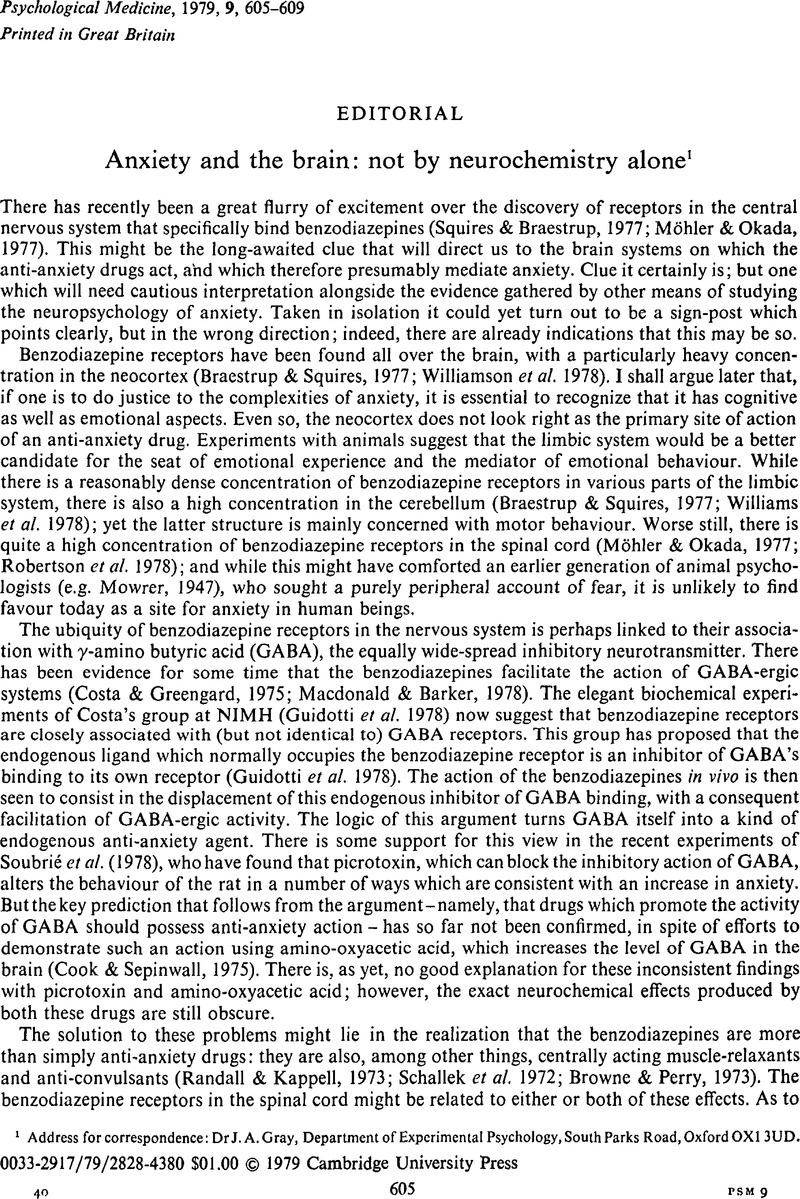Crossref Citations
This article has been cited by the following publications. This list is generated based on data provided by Crossref.
Freedman, Alfred M.
Dornbush, Rhea L.
and
Shapiro, Bruce
1981.
Anxiety: Here today and here tomorrow.
Comprehensive Psychiatry,
Vol. 22,
Issue. 1,
p.
44.
Revelle, William
1982.
The dynamics of action and the neuropsychology of anxiety.
Behavioral and Brain Sciences,
Vol. 5,
Issue. 3,
p.
499.
Iversen, Susan D.
1982.
Integrating the literature on anxiety, memory, and the hippocampus.
Behavioral and Brain Sciences,
Vol. 5,
Issue. 3,
p.
487.
Leslie, Julian C.
1982.
Conditioned suppression and behavioural inhibition.
Behavioral and Brain Sciences,
Vol. 5,
Issue. 3,
p.
489.
Nadel, Lynn
and
Morris, Richard
1982.
On novelty, places, and the septo-hippocampal system.
Behavioral and Brain Sciences,
Vol. 5,
Issue. 3,
p.
493.
Rawlins, J. N. P.
1982.
The relationship between memory and anxiety.
Behavioral and Brain Sciences,
Vol. 5,
Issue. 3,
p.
498.
Crider, Andrew
and
Solomon, Paul R.
1982.
Inhibition, attention, and the hippocampus.
Behavioral and Brain Sciences,
Vol. 5,
Issue. 3,
p.
484.
Panksepp, Jaak
1982.
Anxiety viewed from the upper brain stem: Though panic and fear yield trepidation, should both be called anxiety?.
Behavioral and Brain Sciences,
Vol. 5,
Issue. 3,
p.
495.
Robinson, Terry E.
and
Therrien, Barbara A.
1982.
Does hippocampal theta tell us anything about the neuropsychology of anxiety?.
Behavioral and Brain Sciences,
Vol. 5,
Issue. 3,
p.
500.
Lyons, William
1982.
Some questions of strategy in neuropsychological research on anxiety.
Behavioral and Brain Sciences,
Vol. 5,
Issue. 3,
p.
490.
Ursin, Holger
1982.
Substrates of anxiety: But if the starting point is wrong?.
Behavioral and Brain Sciences,
Vol. 5,
Issue. 3,
p.
503.
Olton, David S.
1982.
Functions of the septo-hippocampal system.
Behavioral and Brain Sciences,
Vol. 5,
Issue. 3,
p.
494.
Gold, Mark S.
and
Fox, Corinne Frantz
1982.
“Antianxiety and opiates”.
Behavioral and Brain Sciences,
Vol. 5,
Issue. 3,
p.
486.
Gray, Jeffrey A.
1982.
Précis ofThe neuropsychology of anxiety: An enquiry into the functions of the septo-hippocampal system.
Behavioral and Brain Sciences,
Vol. 5,
Issue. 3,
p.
469.
Soubrié, Philippe
1982.
Inferring anxiety and antianxiety effects in animals.
Behavioral and Brain Sciences,
Vol. 5,
Issue. 3,
p.
502.
1982.
Brain Sciences in Psychiatry.
p.
311.
Pribram, Karl H.
and
McGuinness, Diane
1982.
The anatomy of anxiety?.
Behavioral and Brain Sciences,
Vol. 5,
Issue. 3,
p.
496.
Gabriel, Michael
1982.
Homunculus in the subiculum.
Behavioral and Brain Sciences,
Vol. 5,
Issue. 3,
p.
485.
Zuckerman, Marvin
1982.
Leaping up the phylogenetic scale in explaining anxiety: Perils and possibilities.
Behavioral and Brain Sciences,
Vol. 5,
Issue. 3,
p.
505.
Kimble, Daniel P.
1982.
Putting anxiety in its place?.
Behavioral and Brain Sciences,
Vol. 5,
Issue. 3,
p.
489.



